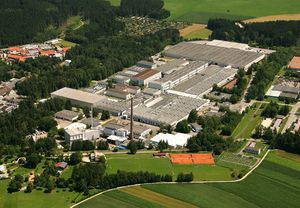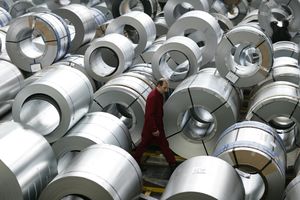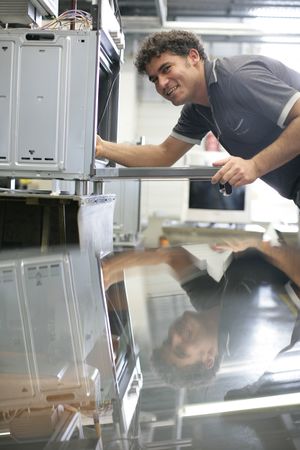The Traunreut Factory
The German armed forces (the "Wehrmacht") established an army munitions facility in St. Georgen in 1938 in a wooded area near the Chiemsee lake. When the war ended, the factory was abandoned and displaced people moved into the former industrial development. Siemens founded a new plant on the site of the former munitions factory in 1949. The plant was discovered by Walter Mohr, Head of Siemens-Schuckert-Kleinbauwerke in Hof. Under his guidance, the plant facilities were redeveloped and the site cleared of the raw materials used for the poison gas grenades formerly produced there.[1] The employees – many of whom were displaced people – lived in the settlements in the vicinity of the plant. A new municipality called Traunreut was founded here in 1950.
Production was on an improvised scale initially. The cooking was simple – "usually stew" – recalls Walter Mohr and goes on to say: "Haymaking was still ongoing at the plant and rabbits and deer were hunted on the grounds, for which we had to grant permission."[2] Yet production was soon operating at a highly professional level.
Production of cookers and light fittings commenced at the Siemens plant in Traunreut in 1952.[3] The plant was incorporated into BSH[4] in 1967.[5] Bosch cookers were also produced here from that time on. In 1971, Traunreut produced the floodlight system for the sports facilities for the Olympic Games in Munich, which were to take place the following year.[6]
Innovation as a key factor
Today, the site mainly produces ovens, compact ovens with integrated microwave and radiant cooktops. More than two million home appliances roll off the production lines annually. Moreover, the development centers for small home appliances, such as fully automatic coffee machines and espresso machines as well as kettles and hair dryers, are located in Traunreut.[7] Innovations are a tradition at Traunreut: the first cooker with oven carriage[8], the first cooker with automatic roasting[9], the cooker with an integrated microwave[10], the first fully electric cooker[11] as well as cooktops with cooking and roasting sensors[12] all came from Traunreut.
Conserving energy and resources was always a top priority at Traunreut. A biomass heating plant was established on the company premises in 1999, which produced more CO2-neutral electricity than the site needed. The excess electricity was given to the municipality of Traunreut. Likewise, the additional heat recovered was fed into the municipal district heating network.[13] Since 2012, the newly constructed container terminal has ensured that many consignments are no longer transported by truck, rather by train, saving around 1,000 truck journeys every year.
The Traunreut location is one of the most important employers and training companies in the region. About 3,000 people are employed in Traunreut today. With 430,000 sqm, Traunreut is the largest BSH location in the cooking product area. More than 2 million appliances in around 1,300 product variants are manufactured here on average per year. Every year, an average of 80 apprentices are trained here. In cooperation with the Rosenheim University of Applied Sciences, BSH offers two dual courses of study at the Traunreut site.
Meilensteine und Entwicklungen aus Traunreut
| Jahr | Entwicklung |
|---|---|
| 1962 | Erster Einbauherd |
| 1977 | Heißluftherd mit Pyrolyse |
| 1982 | Pyrolyseherd mit integrierter Mikrowelle |
| 1997 | Kochfeld mit Kochsensorik |
| 2003 | Ecolyse-Reinigungssystem |
| 2006 | Espresso-Vollautomat mit Calc’n’clean |
| 2006 | Liftbackofen mit automatischer Tür |
| 2008 | Strichcode-gesteuerte Multibeverage Maschine |
| 2014 | Einbaubacköfen mit integrierter Mikrowellentechnik, Backsensor und Home Connect Funktion |
Einzelnachweise
- ↑ BSH Corporate Archives, D01.08-0026, Chronik Traunreut, no page. BSH Corporate Archives, Traunreut Portfolio (D01.08), Erinnerungen Walter Mohr, from page 93. BSH Corporate Archives, A05-0026, inform 2003/3, page 18.
- ↑ BSH Corporate Archives, Traunreut Portfolio (D01.08), Erinnerungen Walter Mohr, page 97.
- ↑ BSH Corporate Archives, D01.08-0026, Chronik Traunreut, no page.
- ↑ BSH was founded in 1967 as Bosch-Siemens Hausgeräte GmbH - BSHG for short. In 1998, the name was changed to BSH Bosch Siemens Hausgeräte GmbH, with the short form BSH. Since the sale of the Siemens shares in BSH to Robert Bosch GmbH the company’s name is now BSH Hausgeräte GmbH, but still BSH for short.
- ↑ Traunreut Site Flyer, page 3; Corporate Archives, D01.08-0026, Chronik Traunreut.
- ↑ BSH Corporate Archives, D01.08-0027, Chronik Traunreut, page 12.
- ↑ Traunreut Site Flyer, page 4.
- ↑ BSH Corporate Archives, D01.08-0026, Chronik Traunreut, no page: Oven Carriage 1970.
- ↑ BSH Corporate Archives, D01.08-0026, Chronik Traunreut, no page: Oven Carriage 1970.
- ↑ BSH Corporate Archives, D01.08-0027, Chronik Traunreut II, page 6: Microwave oven 1980.
- ↑ BSH Corporate Archives, D01.08-0027, Chronik Traunreut II, page 6: Fully electric cooker 1980.
- ↑ BSH Corporate Archives, A01-0019, Business Report 2001, page 17: Frying sensor 2001.
- ↑ Traunreut Site Flyer, page 7; Environmental Report 1998/1999, page 17.


